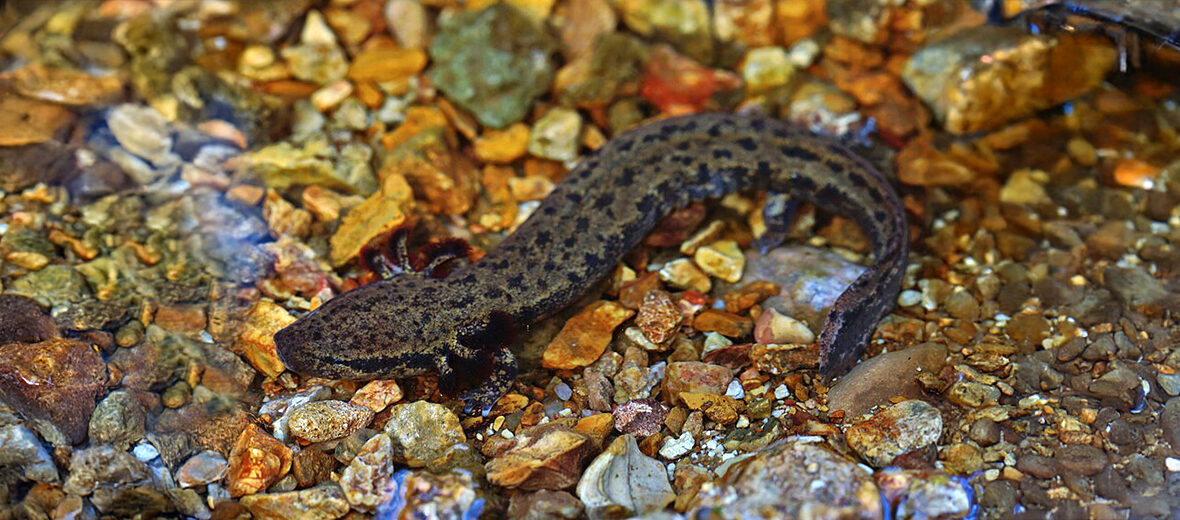
The common mudpuppy is a species of salamander in the family Proteidae. They can be found in eastern Canada and eastern United States. Preferring lakes, rivers and ponds, these salamanders, like the axolotls, never complete metamorphosis and thus remain in the larval stage their entire lives. These critters face the threats of habitat loss and destruction; hunting and trapping, for fish bait; invasive species, and with them disease and predation; and pollution, in the form of water and soil contaminates. However, they are abundant enough to be listed as Least Concern by the IUCN.
First the Stats…
Scientific name: Necturus maculosus
Weight: Up to 7 ounces
Length: Up to 13+ inches
Lifespan: Up to 30 years
Now on to the Facts!
1.) Their external gills look like ostrich plumes and their size is relative to the oxygen levels present in the water. In stagnant water, mudpuppies have larger gill filaments, however in moving streams where oxygen is more rich, their gills are smaller.
2.) They possess mucous glands that produce a slimy coating over their body that aids in protection against parasites.
3.) These salamanders are among many species that fail to complete metamorphosis into land dwelling, air breathing creatures.
4.) The reason behind this is that the thyroid gland in some salamanders, like the axolotl, produce normal thyroid hormones (THs), but cells in these & other similar ones express thyroid hormone receptors (TR) that are mutated, and do not bond correctly with thyroid hormones, thus leading to some salamanders living in a state of perpetual youth.
5.) The common mudpuppy also does not have a parathyroid gland. The majority of salamanders with parathyroid glands rely on them to help with hypercalcemic regulation; hypercalcemic regulation in mudpuppies is primarily done by the pituitary gland instead. Hypercalcemic regulation is the processes and mechanism that maintains calcium levels within a normal range in the blood.
But wait, there’s more on the common mudpuppy!
6.) Mudpuppies are nocturnal (active at night) in clearer water and diurnal (active during the day) in murkier water.
7.) These salamanders can even survive under the ice when lakes freeze.
Did you know…?
In clear, light water, their skin becomes darker, as such in darker water, their skin becomes lighter in color.
8.) Insects and their larvae, annelids, crayfish, mollusks, small fish, other amphibians, earthworms, and spiders make up their diet. But they will literally eat anything moving that they can fit in their mouth.
9.) In turn they are preyed on by fish, crayfish, turtles, and water snakes.
10.) Females lay up to 200 eggs, with an average of 60.
But wait, there’s still more on the common mudpuppy!
11.) The eggs hatch in up to 40 days.
12.) The hatchlings can grow to 1.4 inches before their yolk is completely consumed. After this time they must begin hunting for food.
13.) There are 3 recognized species of mudpuppies: Red River mudpuppy, Lake Winnebago mudpuppy, and of course the common mudpuppy.
14.) These salamanders have homodont dentary teeth. This means that all the teeth are the same type, shape, and size, as opposed to heterodont dentition, where the teeth vary in morphology and function.
Now a Short Common Mudpuppy Video!
Be sure to share & comment below! Also, check out the Critter Science YouTube channel. Videos added regularly!
Want to suggest a critter for me to write about? Let me know here.
Some source material acquired from: Wikipedia & IUCN
Photo credit: Peter Paplanus




